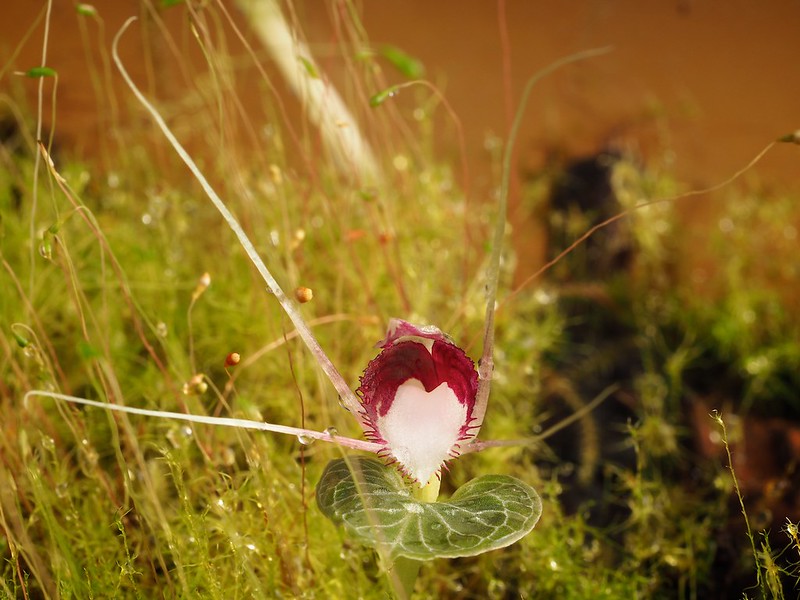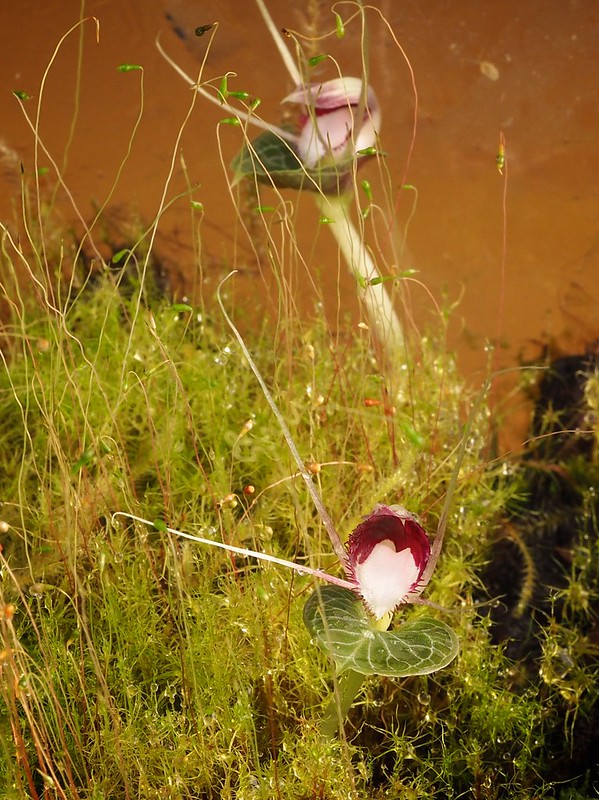
Wow, wow, wow! I haven't had this much surprise and excitement from orchid flowers for a while! There is only 1 more week of lectures this semester, and I get to have a break from teaching tomorrow due to SpringFest. So I had a tiny bit of relaxed time thinking about the neglected orchids. When I opened up the Corybas container which I haven't looked at for 3-4 weeks, there were two small, but superbly wacky flowers greeting me! Indeed, I wasn't so hopeful that they were still alive. The plants gradually became pale and faded away around the last Christmas, so I was assuming that they may be dead. About 1-2 month ago, I did notice that some small leaf-like things were coming out among the carpet of moss, but I wasn't sure if it is the orchid or some weeds.
Corybas geminigibbus is from Malaysia and Indonesia, and its habitat is mossy thick humus in montane forest. In Peninsular Malaysia, it is reported to be abundant but only one locality is known (Go et al. 2015). I heard that Ooi stock is originally from Gunung Jerai, State of Kedah, northern Peninsular Malaysia, elevation 1200m, where it grows in humus on a ridge top in montane rain-foresee, which experiences dry spells. The type locality is Bt. Mulu of West Kalimantan Province (Borneo). Dransfield et al. (1986. Corybas West of Wallace's Line. Reprint from Kew Bulletin 41(3): 575-613) mentioned that the plants from Peninsular Malaysia is not significantly different from plants from Kalimantan, and note that the tip of the dorsal sepal of plants from Peninsular Malaysia is sometimes accurate rather than truncate (of plants from the type locality). Recently (Feb 2016), Alastair Robinson posted a photo of this species taken in a new location in Palawan on Facebook.
I got these plants in May 2015 from Ooi Leng Sun of Malaysia. When I received them, some of them were still dormant tubers, but others were starting to spread the leaves. At that time, I bought both Corybas geminigibbus and C. calopeplos. This came as C. calopeplos, but it was mislabeled, and it is indeed C. geminigibbus. The ones I bought as C. geminigibbus haven't flowered yet, but the leaves look identical. I got about 4 tubers of each, but I think 6 of them are still alive. I wonder how they will do for the second season.
Here is how they looked when I received them:
This is from August 25, 2015. This plant produced a second leaf. The leaves became quite pale. around this time. Then I think it became even paler around the end of 2015, and disappeared. I think I was growing them under old-fashioned blue-red LEDs around this time, and it might have received too much light.
I checked the container once every 2-3 weeks, so I didn't carefully observe the growth pattern. Well, I was almost giving up last fall! I should be more observant this year.
Here is the current state in April 21, 2016:



Culture:
I couldn't find much info about how to grow this species. So I'm listing my condition below. But I have only grown it for a year, so I don't know much about the culture of this species yet.
Media: They are grown in a spinach container from grocery store (8 holes drilled at the bottom and top of the container). The top is closed all the time. Potting media is coarse Perlite : backyard moss (looks like "feather moss") : Carquest UltraSorb Diatomaceous Earth, Item # 8826, Moltan Sorbent ($16/25lb) : Better Gro Med Bark : river sand = 45% : 30% : 10% : 10% : 5%. Also, I mixed in fair amount of corrugated cardboard cut into 1cm/1cm squares. The depth of media is about 2.5cm (1 inch).
Light: pretty weak, 260fc (or less) from 4000K Sunritek 12W T8 LED (link to my blog post about this LED).
Min/max temperature: 18/27C (65/78F) in summer, 13/18C (55/65F) in winter. I heard 22C day and 15C night is a good target.
Water: once every 2-4 weeks. Since it is completely enclosed, they are kept really moist. Not much fertilizer (30ppmN less than once every month).
Conservation issues of this species and other Corybas are discussed in the following paper:
While I was shooting the photos, my 4 year old son, a little biologist, came there after his bath. He wanted to show us his impression of this wonderful orchid:




Thanks Naoki!
ReplyDeleteDo you have an update? Can you comment on the growth cycle?...TIA, Ree (AKA AnonYMouse from the boards)
Thank you for the comments, Ree. Good to hear from you! I didn't take good notes, but I think they went to dormant relatively late (Nov.-Dec. I think) last year. So they haven't started to grow yet this year. Most of them were covered by moss, so I can't see how they are doing, but I can see one tuber sitting in there. Are you growing this species?
DeleteThanks! I ordered geminigibbus from OLSO and picked them up at the SF show. Wasn't sure when they come out of dormancy so I planted one and plan to stagger the others (received 4, dropped one down the sink drain *facepalm*). Keeping the temps low during summer is going to be a challenge but being low light will help. Wish me luck! I'll keep my fingers crossed for both of us...Regards, Ree
DeleteHave you any updates? I'm wondering - it's 3 years later. I've just got a couple of corybas.
ReplyDeleteThey are still doing OK. I think they flower in the spring and are slowly increasing the number of leaves. I do keep them moist even in the winter time. I experimented with removing the top of the container (and frequent watering (like every 3 days). This gives more light and less humidity. I can't say which is better, they seem to do well in either. But with the enclosed environment, the moss start to take over. Corybas doesn't seem to mind too much, though.
DeleteHello Naoki, cnycharles from slippertalk. How are these doing? Do you fertilize? Have you had more flowers?
ReplyDeleteThanks,
Charles
Good to hear from you! I've been busy a bit, but I would love to be back to ST when I get more time. The number of leaves has increased a little bit, but it seems to be pretty slow. So I wouldn't say that they are doing fantastic. It does make a couple flowers every year. I have some growing in fairly enclosed container like the original post. Others, I tried to leave the top out (it still has fairly high side walls) to see if more light and less humidity is ok. So far I haven't noticed much difference in these two containers. With the top closed, the moss goes crazy, and the open-top seems to be better in this aspect. How is yours doing?
DeleteAmazing! Do you repot the tubers every year or have they been in the same container this whole time?
ReplyDeleteI have repotted into a smaller container once (probably 3 years ago). But it's been in the same container since then. A couple flowers opened a couple weeks ago.
DeleteThank you! It seems daunting, but maybe I'll give these a try.... :)
DeleteJust wondering, it seems some people prefer to unpot the tubers during the dormancy period and keep them less wet to prevent rot; what is it about your conditions that makes it possible to keep them in the container year-round, do you think?
ReplyDeleteI don't know. I reduce the watering in the winter a little bit. The number of leaves doesn't seem to increase quickly over the 5 years which I have kept them, so the way I'm keeping might not be optimal.
DeleteI see, thanks!
ReplyDelete